Avid twitchers will be descending on the Algarve this weekend for the Sagres Birdwatching Festival, the largest event dedicated to birds in Portugal. Organised by the Portuguese Society for the Study of Birds (SPEA), the event takes place from October 4 to 6 and is expected to attract a large international audience.
Although the main attraction are unquestionably the birds, this year there will also be workshops and field days covering different themes such as astronomy, mushroom foraging, nocturnal butterflies, sharks and more. There will also be dolphin-watching and the opportunity to go horse riding or donkey walking.
The decision to diversify the festival’s activities came from the need to give more importance to the region’s natural heritage, with a focus on developing the nature tourism segment, explained Nuno Barros from SPEA.
The objective is to complement birdwatching with other activities that are linked to nature observation and are family-oriented.
Sagres peninsula is integrated within the Natural Park of the Southwest Alentejo and Vicentina Coast and is also one of the most important bird zones in Portugal.
This area is home to unique species and is also the stage for a natural phenomenon that happens nowhere else in Portugal – the autumn migration of soaring birds.
From August to November, this area becomes the main migration route in Portugal for birds such as storks, eagles, vultures, hawks and falcons, and it is possible to observe practically all soaring birds, including some rare ones.
Sagres is equally an interesting spot to observe marine birds, steppe birds and passerine birds.
The bird migration phenomenon in Sagres includes mainly birds of prey, marine birds and passerines, as well as some nocturnal birds. Birds of prey are the main focus of interest during the festival.
Species such as the Booted Eagle (Aquila pennata), the Short-toed Snake Eagle (Circaetus gallicus), the Eurasian Sparrowhawk (Accipiter nisus) and the Griffon Vulture (Gyps fulvus) can be seen in large numbers.
The migration period actually runs from August to November, with flying patterns varying according to species and wind direction, so anything is possible during the festival and it is impossible to predict what will happen.
Other species that can also be spotted but in fewer numbers are the Black Stork (Ciconia nigra), the Egyptian Vulture (Neophron percnopterus), the European Honey Buzzard (Pernis apivorus) and the Black Kite (Milvus migrans).
The species that bird aficionados are more eager to observe are, of course, the ones that are spotted only occasionally such as the Golden Eagle (Aquila chrysaetos), the Iberian Imperial Eagle (Aquila adalberti), the Bonelli’s Eagle (Aquila fasciata) and the Cinereous Vulture (Aegypius monachus).
Nocturnal birds such as the Long-eared Owl (Asio otus) or the European Scops Owl (Otus scops) can also be observed, but in smaller numbers and mainly during dusk or night-time.
Marine birds that use the Sagres migration route include the Northern Gannet (Morus bassanus) and the Cory’s Shearwater (Calonectris diomedea), which can be seen in their thousands, and the Balearic Shearwater (Puffinus mauretanicus) which is spotted in smaller numbers.
Birdwatching activities will take place throughout the day, but participants must take note that birds fly in a rising air current, called a thermal, and so the first hours of the morning and cloudier periods provide undesirable conditions. To maximise on your birdwatching experience, the use of binoculars or a telescope is recommended and SPEA will make the necessary equipment available to participants.
Last year’s Sagres Birdwatching Festival attracted 800 participants from 10 nationalities. This year, organisers expect similar numbers. For the full festival programme and further information in English, please visit the website.
birdwatchingsagres.com
























